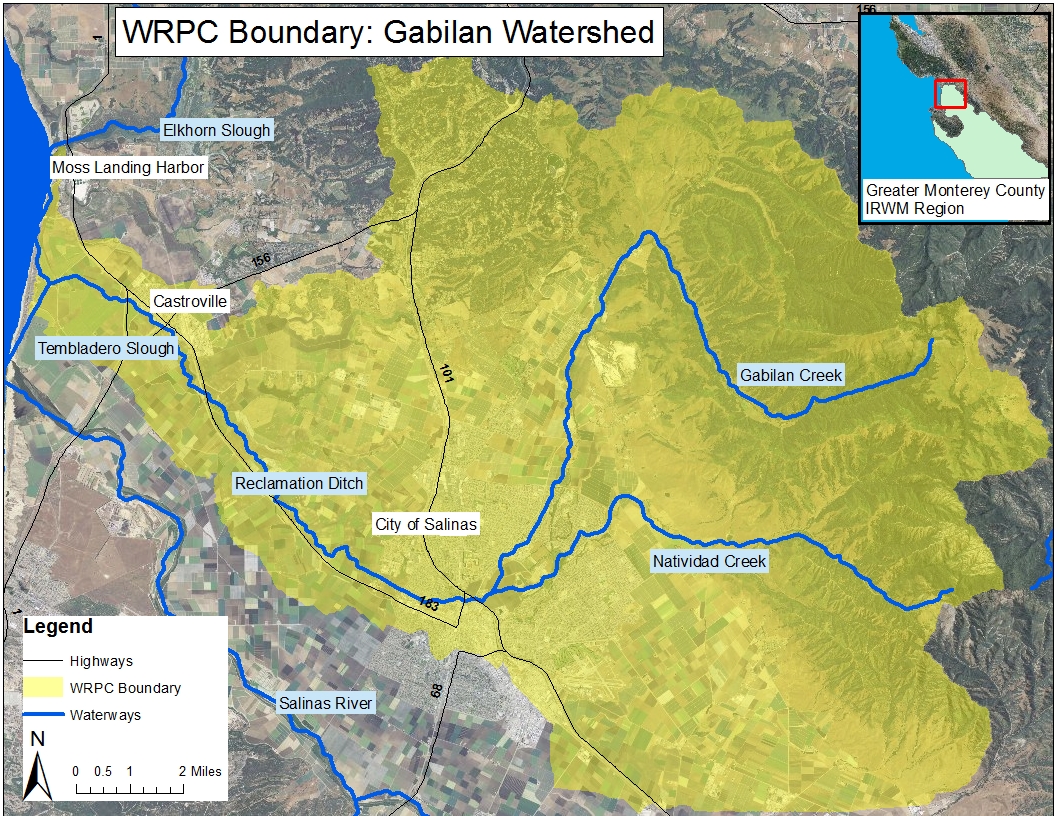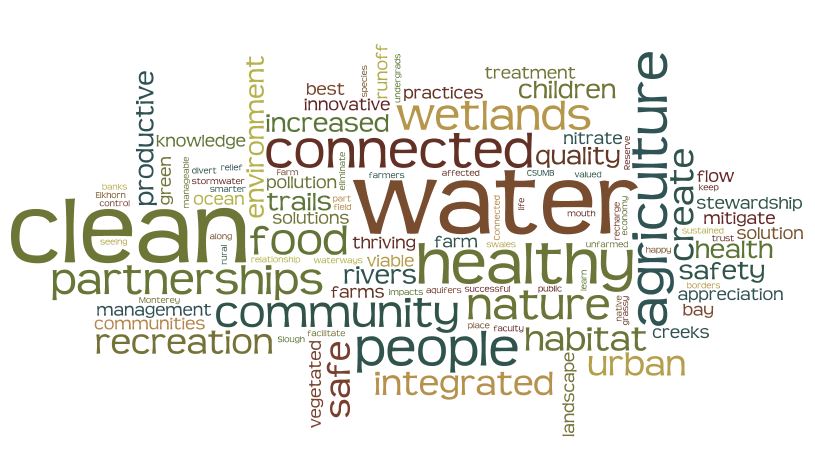Water Resource Project Coordination
One important effort that has resulted from the project integration process for the Greater Monterey County IRWM Plan is the Water Resource Project Coordination (WRPC) process. The WRPC process represents an innovative approach aimed at addressing and resolving water-related conflicts in the region, while promoting stakeholder collaboration and project integration.
While many attempts at traditional conflict resolution in Monterey County have been made in the past, most of these attempts have failed. The Greater Monterey County Regional Water Management Group (RWMG) concluded that a new approach was needed to foster collaboration and enable project integration to occur. In response to this need, the RWMG developed the “Water Resource Project Coordination” concept. The goal of the WRPC process was to alleviate areas of mistrust and confusion and increase collaborative dialogue so that mutual solutions could be achieved. Beginning from a solutions-based platform, stakeholders would share data, experiences, concerns, and viewpoints to develop a result that all involved could support
WRPC Pilot Project: The Gabilan Watershed
The RWMG requested and received grant funds through the Proposition 84 IRWM Round 1 Planning Grant to test the WRPC process as a pilot project in one watershed area of the Greater Monterey County region. The Gabilan Watershed was selected as the focus area for this pilot project (see map below). Out of the 64 projects included in the IRWM Plan at the time that the WRPC pilot process was being developed, 35 were located within the Gabilan Watershed. The sheer number of projects located within this one watershed presented some unique opportunities for collaboration; however, some of the projects appeared to have potentially conflicting goals, which would need to be resolved or somehow reconciled for those projects to comfortably co-exist in the IRWM Plan, as well as for project integration to occur.
Figure 1: Boundary for the WRPC Pilot Project: Gabilan Watershed
The first stakeholder meeting for the WRPC pilot project was conducted in January 2012, with 20 individuals in attendance. The purpose of that meeting was to set the stage for the WRPC process, to discuss what the end goals were, and to begin the process by selecting a facilitator. The WRPC Committee emphasized the potential benefits of the process, namely, that by agreeing on shared principles for the watershed, stakeholders could maximize project integration and the competitive advantage of regional projects, ultimately bringing in more funding to the region.
In May 2012, the facilitator for the Gabilan Watershed WRPC pilot project began interviewing key stakeholders individually to get a comprehensive perspective on the various issues in the watershed. Some of their observations included the following:
▪ Ag Waiver: The Central Coast Regional Water Quality Control Board’s Conditional Waiver of Waste Discharge Requirements For Discharges From Irrigated Lands (known as the “Ag Waiver”) and related legal actions was identified as contributing to increasing the challenge for solution–seeking collaboration between people and organizations in this region. This polarized climate seemed to have fundamentally shifted the local collaborative environment.
▪ Outcomes of the “Spinach Scare”: In 2006, an outbreak of E. coli from contaminated spinach originating in the area resulted in significant public relation, legal, and regulatory impacts.
▪ Existing Local Collaborations: The richness and diversity of existing and emerging collaborative projects was considered impressive and hopeful.
A decision was made to focus on identifying “shared values” in the Gabilan Watershed rather than moving directly to trying to find solutions to areas of disagreement.
The second stakeholder meeting in January 2013 meeting began with the participants sharing their understanding of the challenges facing the region, including social, economic, and environmental issues and trends, by placing anonymous sticky notes on a map. In this way the “elephants in the room” were brought out into the open without individuals needing to self-identify as proponents or opponents. After discussion about the challenges, the participants were divided into “affinity groups,” including agriculture, research, conservation, and government. Each group was asked to discuss amongst themselves their priorities for the watershed. Each participant was asked to create a visual image of their “desired future” for the watershed, its characteristics, and what they saw to be the key obstacles and opportunities for success.
The visioning process then focused on synthesizing what the affinity groups had reported as “common ground,” as “tough spots” (i.e., significant or irreconcilable differences, or barriers to progress), and finally, as emerging solutions that should be explored further. From the groups’ images and discussion, it became clear that there was actually more common ground amongst stakeholders than anticipated.
After the workshop, a “Wordle” was generated based on the number of times certain words were used during the graphic imaging process by the different affinity groups (i.e., the more often the word was used, the larger it appears in the Wordle).
Figure 2: WRPC Stakeholder Workshop Wordle
Based on the outcomes of the January 2013 stakeholder meeting, the WRPC Committee determined that the challenges to “making progress” in the Gabilan Watershed had less to do with a lack of information and more to do with funding constraints and other barriers. The challenges spanned such a large range of topics that the Committee felt a comprehensive “umbrella” was needed, which they termed the “Gabilan Watershed Blueprint.”
The Gabilan Watershed Blueprint was envisioned as a process to address some of the major hurdles that have slowed and prevented progress in resolving problems related to water quality, and to a lesser extent flooding, in the Gabilan Watershed. Stakeholders were brought in to help design the outline of the Blueprint, and a third stakeholder meeting was held in June 2013 (attended by about 30 individuals) to recruit Blueprint “working groups.”
The Gabilan Watershed Blueprint has four main “sections,” designed to address some of the regional challenges and opportunities expressed during the January 2013 stakeholder meeting. The four Blueprint sections are 1) The Landscape Strategy, 2) On-Farm Solutions, 3) Corporate Social Responsibility, and 4) Agency Coordination. These sections are described briefly below. The final Blueprint document can be downloaded as a complete document or by each section at the end of this webpage.
1. The Landscape Strategy
One important outcome of the January 2013 WRPC stakeholder meeting was the collection of visual depictions of ideal and/or desired future characteristics of the Gabilan Watershed. The WRPC Committee was struck with how closely aligned many of these depictions were. The purpose of the Landscape Strategy was to bring these images together in order to outline common goals for the watershed and to describe some of the common hurdles affecting the ability to advance joint work in the watershed. The images in the Landscape Strategy also provide a way to show what common themes such as “triple bottom line” (i.e., people, planet, and profit) and “multiple benefits” could actually look like.
2. On-Farm Solutions
Some of the challenges voiced at the January 2013 WRPC stakeholder meeting were the “barriers” to implementing on-farm sustainable management practices. One barrier was a simple lack of technical information regarding certain practices, such as nutrient management practices, and the lack of an industry-led approach to address the issue. In response to this challenge, a decision was made to allocate some WRPC funds to help growers answer some of those questions in order to help build capacity within the local grower community for implementing sustainable management practices in the Gabilan Watershed.
On-Farm Solutions was developed by the Grower-Shipper Association (GSA) to assist growers with water quality improvement management practices. One identified need was a focus on better understanding Nitrate Quick Tests, including how to use them, compile them, and interpret them, and their true cost to the grower. The On-Farms Solution Blueprint section contains Standard Operating Procedures on using Nitrate Quick Tests, plus a cost analysis and an article that explains in-season soil nitrate testing.
3. Corporate Social Responsibility
Like “On-Farm Solutions,” the goal of this Blueprint section was to advance agricultural sustainability in the Gabilan Watershed. With “On-Farm Solutions” working on the individual grower level, the Corporate Social Responsibility (CSR) part of the Blueprint was intended to address the next level of the agriculture industry. SureHarvest, a private consulting company that provides solutions to growers and agrifood companies pursuing sustainability strategies, was hired to lead this effort.
The goal of the effort was to initiate greater dialogue within the agricultural industry about social/environmental responsibility programs, and to encourage agricultural leaders to take a greater role in funding sustainability practices. In March 2014, SureHarvest convened an industry-focused working session in the City of Salinas to bring together CSR leaders in the agricultural community to initiate an action-oriented discussion focused on advancing business models for stewardship of Monterey Bay watersheds. A summary report of the CSR workshop comprises this section of the Blueprint document.
4. Agency Coordination
One of the major challenges to project implementation identified during the January 2013 WRPC stakeholder workshop was permitting and regulatory compliance. Hurdles to project implementation brought about by lack of interagency coordination and difficult and confusing regulation were voiced time and time again at the January 2013 stakeholder meeting. The goal of Agency Coordination section of the Blueprint was to identify the regulatory constraints and challenges that projects in the Gabilan Watershed might encounter, and identify possible options for coordinating agency review and consultation. The result was a matrix summarizing primary permitting and regulatory oversight (see Table 3). The matrix is a linked document which gets the project sponsor or member of the public to the official website of the agency.
As the final product of the WRPC process, an effort was initiated to integrate projects within the Gabilan Watershed. The project integration process proceeded in two phases: 1) review of all existing IRWM Plan projects located in the Gabilan Watershed to identify integration options, and 2) discussions with a wide variety of project proponents to identify possible partners and integrated project components. The result was identification of several integrated multi-objective, multi-stakeholder projects that can potentially be developed and put forward for IRWM and other grant funds. These projects are briefly described in the Agency Coordination Final Report.
Next Steps
The Gabilan Watershed Blueprint document – including the visioning graphics, the Nitrate Quick-Test guide and website, CSR efforts on the Central Coast, and the regulatory matrix – will continue to be used as an educational outreach tool to engage additional stakeholders. As opportunities arise, these educational tools will be brought to other areas of the Greater Monterey County region to initiate a similar project development/integration process, building off the momentum of what has occurred in the Gabilan Watershed.
The Gabilan Watershed Blueprint:
The Complete Gabilan Watershed Blueprint
Gabilan Watershed Blueprint Introduction
Section I – Integration Chapter for IRWM Plan
Section I: Landscape Strategy
WRPC Multi-benefit Landscape imagery
Section II: On-Farm Solutions
On-Farm Solutions_Nitrate Quick Test SOP_English
On-Farm Solutions_Nitrate Quick Test SOP_Spanish
On-Farm Solutions_App A_Cost Analysis_English
On-Farm Solutions_App A_Cost Analysis_Spanish
On-Farm Solutions_App B_Soil Nitrate Testing Explained_English
On-Farm Solutions_App B_Soil Nitrate Testing Explained_Spanish
Section III: Corporate Social Responsibility
Advancing Business Models for Ag Stewardship
Section IV: Agency Coordination
Agency Coordination Final Report
Agency Coordination table 2 – Monterey Agency Contact List
Agency Coordination table 3 – Permitting Matrix
Agency Coordination table 4 Project Integration Matrix



